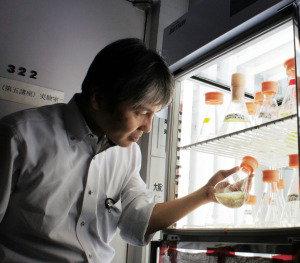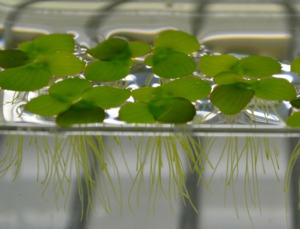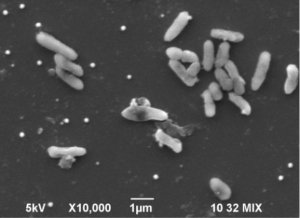Michihiko IKE

Position: Professor
Degree: Philosophy Doctor (Engineering)
Laboratory: Bio-Environmental Engineering Laboratory
to Laboratory Homepage
Water purification and resource production using the symbiosis between aquatic plants and microbes
A variety of microbes that purify environmental pollutants were found to exist in the root zone (rhizosphere) of aquatic plants such as duckweeds. In addition, it was discovered that some microbes in the rhizosphere nourish and promote a two- to five-fold growth of the aquatic plants. Based on such discoveries, we are developing water purification systems to remove the nitrogen and phosphorous, which cause eutrophication, and the chemical substances that pose risks to human health and to ecosystems. This involves fostering the symbiotic relationship between aquatic plants and microbes without using energy or other resources. Furthermore, we are developing co-benefit systems that serve two purposes, namely, purifying water and growing biomass as a resource, and have succeeded in converting the biomass into ethanol or plastic materials.

[Duckweed applied for water purification and resource production]
Recovery of valuable metals from wastewater/waste using metal biotechnology
Certain microbes transform metals in various ways, including oxidization, reduction, and methylation. Such metal transformation offers a method of environment purification and resource maintenance, with the removal/recovery of metals from the water and the soil, and the detoxification of harmful metals. The technique based on microbial metal metabolism has been termed “metal biotechnology,” and we are continuing to focus on developing technologies for recovering rare metals from wastewater and waste. Here, we have discovered microbes that have the ability to solidify (insolubilize) and recycle the rare metal, selenium, from wastewater, which is applicable to industrial wastewater treatment. In addition, we have discovered methods for the detoxification of arsenic, the recovery of vanadium and antimony from water, and the synthesis of semiconductor nanoparticles.

[Microbes that can insolubilize and recover selenium (→ shows selenium particles)]
Enhancing the energy self-reliance of a sewage treatment plant and developing it into a power station
Sewage contains organic materials mainly derived from excrement and kitchen refuse, which have chemical energy. A sewage treatment plant consumes a large amount of energy for decomposing the materials into clean water, meaning it could present a site for extracting energy from the materials. We are currently aiming to extract chemical energy from sewage using microbes and then converting it into methane gas for the generation of electricity. With this, sewage treatment could be conducted without consuming energy, that is, energy self-reliance could be achieved. In fact, this approach could allow sewage treatment plants to become power stations. We hope to actualize this plan through the development of highly efficient methane fermentation technology, through microbial fuel cells, and through the process of converting the sewage material into a form that allows for easy energy conversion.
Publication
- Ishizawa H., Ogata Y., Hachiya Y., Tokura K., Kuroda M., Inoue D., Toyama T., Tanaka Y., Mori K., Morikawa M. and Ike M.: Enhanced biomass production and nutrient removal capacity of duckweed via two-step cultivation process with a plant growth-promoting bacterium, Acinetobacter calcoaceticus P23, Chemosphere, 238, 124682 (2020).
- Kuroda M., Suda S., Sato M., Ayano H., Ohishi Y., Nishikawa H., Soda S. and Ike M.: Biosynthesis of bismuth selenide nanoparticles using chalcogen-metabolizing bacteria, Applied Microbiology and Biotechnology, 103, 8853-8861 (2019).
- Zhang Y., Kuroda M., Arai S., Kato F., Inoue D. and Ike M.: Biological treatment of selenate-containing saline wastewater by activated sludge under oxygen-limiting conditions, Water Research, 154, 327-335 (2019).
- Ishizawa H., Kuroda M., Inoue K., Inoue D., Morikawa M. and Ike M.: Colonization and competition dynamics of plant growth-promoting bacteria in the phytosphere of the duckweed Lemna minor, Microbial Ecology, 77, 440-450 (2019).
- Takada K., Shiba T., Yamaguchi T., Akane Y., Nakayama Y., Soda S., Inoue D. and Ike M.: Cake layer bacterial communities during different biofouling stages in full-scale membrane bioreactors, Bioresource Technology, 259, 259-267 (2018).